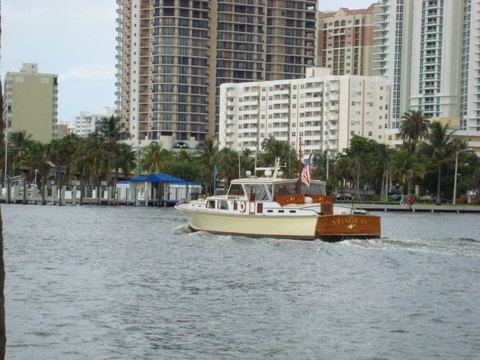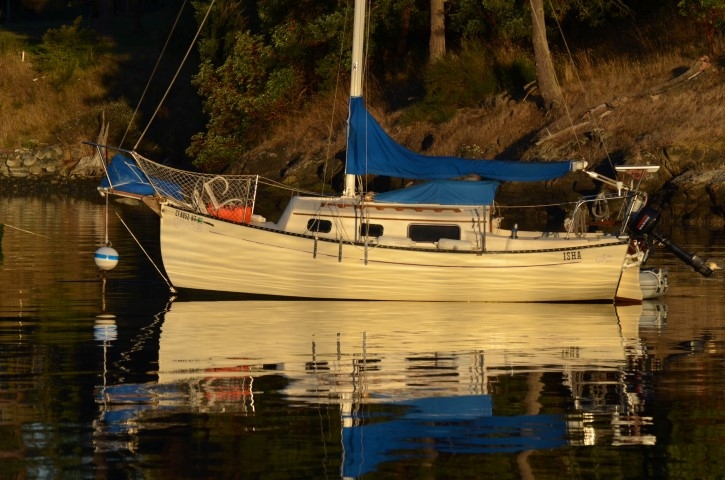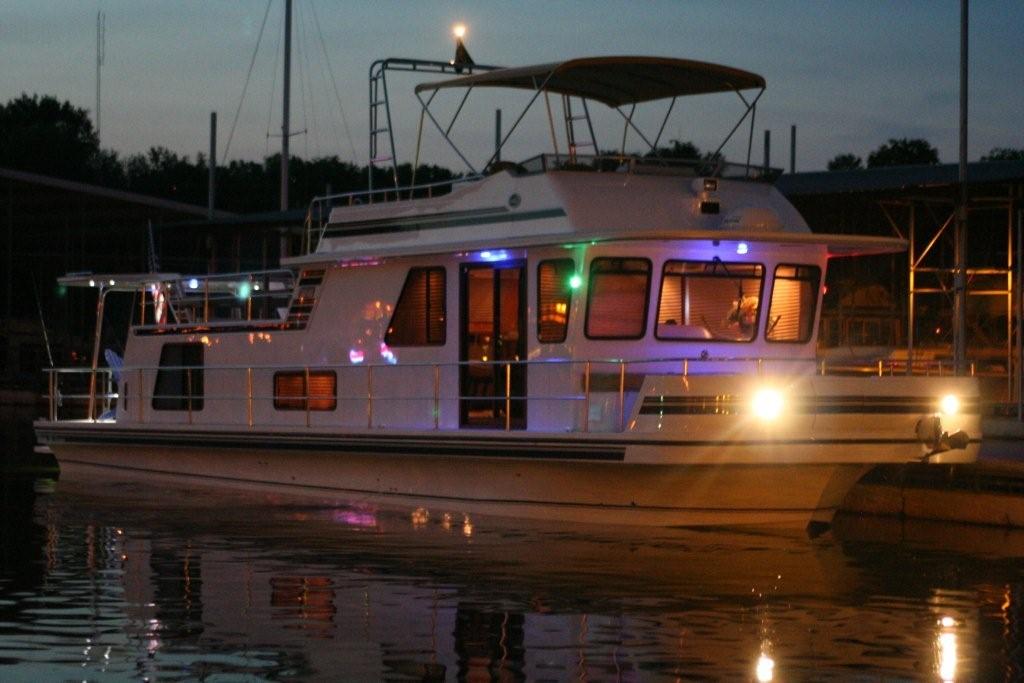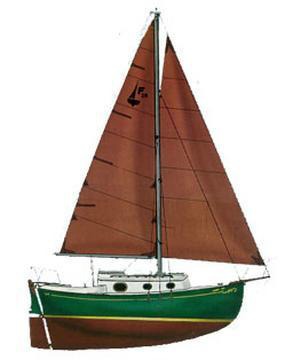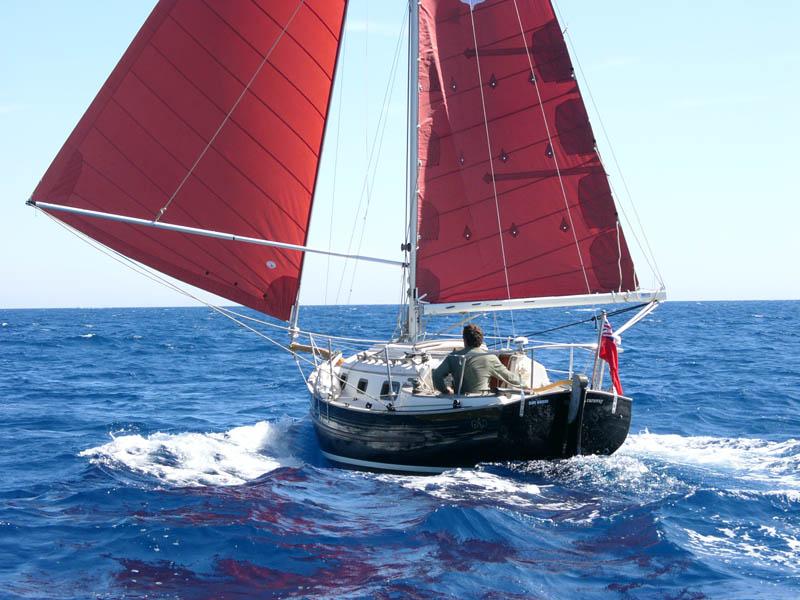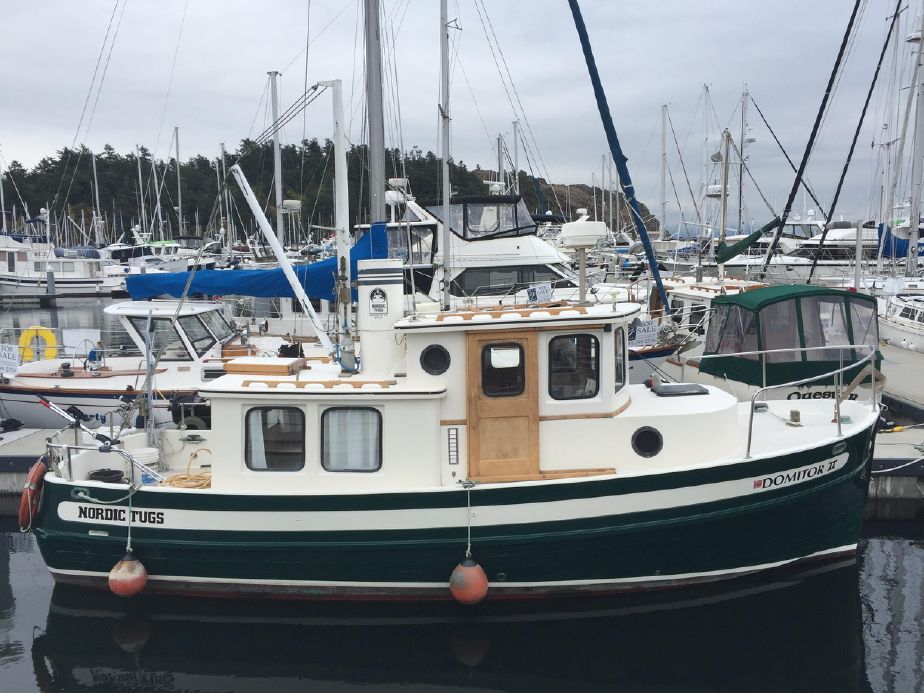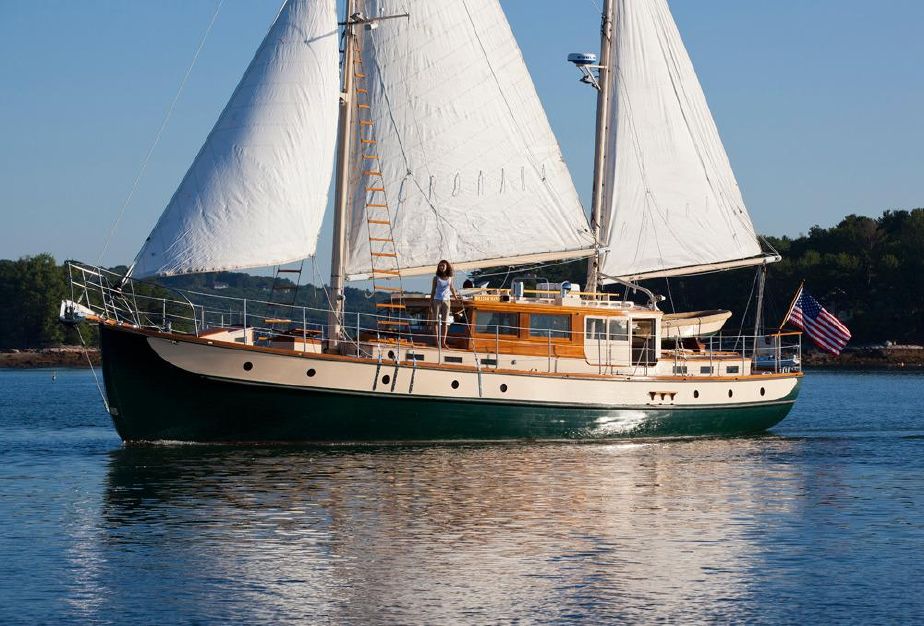TYPES OF LIVEABOARD BOATS
There are many types of boats in all sizes and shapes that can make a good liveaboard home. People have been known to live aboard almost anything that floats including rafts. The allure of life afloat is thousands of years old.
These days most people consider living aboard a power boat, a sail boat, a trawler, a motor sailer or a houseboat with or without an engine. Here's some information about living on a boat in all of these categories.
You can either click on a photo or scroll down.
TYPES OF LIVEABOARD BOATS
LIVEABOARD POWER BOATS
Of all the types of liveaboard boats, power boats give you the most living space per foot of boat length. They have a lot of space above the waterline which means good news for headroom and storage space.
All of this space is a disadvantage, however, in boat handling because of the windage caused by the tall deck house and hull.
Displacement boats (including sailboats and trawlers) can only go about 1.33 times the square root of their waterline length.
This provides decent fuel economy but slower speeds.
For example, a displacement hull with a waterline length of 30 feet has a maximum theoretical hull speed of 7.3 knots or about 8.4 miles per hour.
If I won the lottery and could buy the power boat of my dreams, I'd get the comfortable displacement cruiser shown in the photo above loafing along the Intracoastal Waterway in Fort Lauderdale near Bahia Mar.
A planing power boat like the one in the photo above, however, needs a lot of energy to get up on top of the water and flatten out for higher speeds. It will gobble fuel at a horrifying rate.
If you plan on spending most of your time in a marina, you night not want to pay for all of that speed potential with its higher operating and maintenance costs.
There are also multihull power boats including quite a few good catamaran designs. These are more economical to run than a monohull power boat of equal length, and can negotiate shallower waters because of their hull design.
The photo above is a PDQ Power Catamaran I spent a night with at a marina in Stuart, Florida. I have seen many of these cruising in Florida, and they look like great liveaboards.
It was very windy that night in Stuart and the PDQ rode very gently at the dock when many other boats in the marina were pitching around quite a bit.
These catamarans are one of the types of liveaboard boats that allow you to live aboard and explore in shallow waters.
LIVEABOARD SAILBOATS
I have loved sailing since my boyhood days and would live on a sailboat no matter its disadvantages. I just feel right aboard a sailing vessel. If you like sailboats too, you have a lot of choices.
Even though most monohull sailboats don't have as much interior room as a trawler, houseboat, power boat, or multihulled vessel, I like to sail.
I like being able to use the wind to get from Point A to Point B and I like the sound of halyards slapping against the mast when I'm in an anchorage or mooring field or marina on a windy night.
Sometimes in marinas a neighbor or dockmaster will complain about the clanging halyards and I'll have to tie them down. Otherwise the sound is as appealing to me as church bells might be for others.
Most sailboats can be lived aboard with enough comfort that they can be considered to be liveaboard boats. Some are better than others, and here are a few of my favorites.
LIVEABOARD MONOHULL SAILBOATS
As the name implies, these boats have a single hull. They usually have a fairly deep keel or centerboard that limits the places you can liveaboard. You will usually have to forego shallow marinas or moorings.
Space is also a problem. Sailboats have pointy ends, the forward one known as the bow, and the sides of the hull are curved. This presents a problem for headroom and storage space.
The mast height also limits you to marinas that are not constrained by low overhead bridges.
The cutter rigged monohull sailboat above was in Pier 66 Marina in Fort Lauderdale when this photo was taken. It would be a comfy and spacious liveaboard. The large pilot house with abundant glass means plenty of light below and good headroom.
Another example of this type of sailboat is the CSY-33. Although it's no longer in production, a good used one can be an ideal liveaboard. These types of boats - pilothouse sloops or cutters - are very comfortable homes afloat.
Don't let budget or size discourage you from living aboard. Many people have lived aboard the Flicka, a twenty foot long sailboat formerly manufactured by Pacific Seacraft.
SOME FAVORITE LIVEABOARD MONOHULL SAILBOATS
The Pacific Seacraft Flicka - A Pocket Sized Liveaboard
A Flicka may be one of the smallest boats that I could consider a liveaboard. Plenty of people would agree.
The Pacific Seacraft Flicka is only 20 feet long on deck, and is almost the same length on the waterline. It has tremendous room below for such a small boat and has served as a liveaboard home for many people.
The Flicka has even made several Atlantic and Pacific crossings and circumnavigated the globe. This small boat proves you don't need a big boat to live aboard.
The designer of the Flicka, Bruce Bingham, lived aboard with his then companion, naval architect Katy Burke for many years. They made it their full time home and cruised extensively.
Island Packet 27 - A Beamy Roomy Liveaboard
An Island Packet of any size and vintage makes a wonderful liveaboard sailboat. They are extremely well built, beamy and offer a lot of room below.
The entry level Island Packet for many years was the IP26, and it was superseded in following years by the IP27. Island Packet no longer makes these boats; they have moved into larger and larger sailboats over the years.
Good used IP26s and IP27s are available on the used market for prices in the range of $35K to $45K. These are among the few Cadillacs of American sailboats.
Nonsuch 30 Ultra - A Roomy Liveaboard That's Easy to Sail
The Nonsuch 30 has an amazing amount of room below because it is rigged as a catboat with the mast stepped far forward in the bow.
The boat is no longer manufactured. It was made in Canada in the years 1978 to 1995. More than 500 of the 30 foot model were manufactured.
I first saw one at the Miami International Boat Show in 1980 and fell in instant love. Not only is the boat solid and well made, it has a very liveable interior and even includes a separate shower. The Ultra model, shown in this floor plan, has a pullman berth on the port side forward and an amazing amount of hanging locker space.
The simple sailing rig means that even an old sailor can single hand this beautiful craft.
The very active International Nonsuch Association has a website where you can learn a lot about the boat.
LIVEABOARD MULTIHULL SAILBOATS
Multihulls include catamarans (two hulls) and trimarans (three hulls).

The advantage to these boats are shallow draft, speed underway and a lot of liveaboard space. You have almost twice as much space as a monohull.

One of the disadvantages, however, is you will usually have to pay a lot more for a marina slip unless you have a smaller catamaran with a beam of 14 or 15 feet that can fit in some of the larger slips.

Larger catamarans like the ones in the photo above will usually require two slips in a marina or will have to be tied off at the end of a tee dock.
LIVEABOARD TRAWLERS
A trawler is a power boat with a displacement hull that is designed for long economical voyages under power at something less than theoretical hull speed. Sometimes the trawler will have a steadying sail to help it withstand rolling motion while underway.
Sometimes they also have "flopper stoppers", devices that you lower from booms extending over the sides of the boat down into the water. The stoppers provide resistance to rolling at anchor or on a mooring.
The trawler in the photo above has tremendous room below because of the vertical sides of its hull and the large deckhouse. It might be a bit tough to handle maneuvering around a marina in windy conditions, but would be a comfortable liveaboard, especially in a marina.
One of the most popular trawlers, and one that seems to hold its value very well, is the Grand Banks.
Bill Tighe of Willard Boat Works built a 40 foot custom trawler for himself and his wife, Renee. It was named the "Renee Tighe" and Bill called it "a trawler with auxiliary sail power".
Several manufacturers have created trawler type boats referred to as tugs. Not only are they attractive and rugged looking, they have a lot of room below for their size. The one in the photo is a 1982 model.
LIVEABOARD HOUSEBOATS
These are usually boats with a flat bottom and a large house that occupies most of the deck. They are usually designed for calmer waters like rivers or some lakes. The photo below is from the Gibson Boat Company website.
HOUSEBOAT WITH ENGINE
You see a lot of houseboats in inland lakes and rivers. They are usually not considered seaworthy enough to take out in the open ocean or one of the Great Lakes.
Their flat bottoms make for a very uncomfortable ride, but in calmer conditions they have unsurpassed comfort.
HOUSEBOAT WITHOUT ENGINE
These are barge type boats that are designed to be towed wherever they will be located. They quite often don't move for years. They are usually permanent fixtures in some marinas or liveaboard communities.
The houseboat in the photo above was at a fish camp on the Dead River in Central Florida near Eustis and Tavares.
LIVEABOARD MOTOR SAILERS
Many experienced liveaboards swear that a motorsailer is the best way to go.
A motorsailer is designed to be a better performer under power than the average sailboat of equal length. By the nature of their design, they are usually a bit slower under sail than the average sailboat of equal length.
It is one of the types of liveaboard boats that can satisfy both sailors and power boat fans.
Many motorsailers have a lot more space than a sailboat because of the typically large deckhouse and hull shape.
The motorsailer shown above has a very large deckhouse and a relatively small sailing rig.
It has a tremendous amount of living space below and would be a very comfortable liveaboard.
Note the Bimini Top over the cockpit and the inflatable dinghy on davits. It is all decked out in red ribbons to celebrate Christmas aboard at Burnt Store Marina near Punta Gorda, Florida.
Most marinas are delightful places to be during the holiday season. Liveaboards can be very creative with their decorations.
Cape Dory Yachts created a beautiful little motorsailer known as the Cape Dory 300. Many of them have proved to be good live aboard boats with good performance under both power and sail.
William Hand was a well known naval architect who designed many beautiful motorsailers. This 63 foot beauty was built in 1933 and was for sale in 2018 at YachtWorld.com for one million dollars.

Over 6,458 fans can't be wrong.
See if living on a boat is the life
for you. Like us on Facebook.
20191115typesofliveaboardboatsGI2-820pv
- Home ›
- Types of Liveaboard Boats
By Mike Miller, Copyright 2012-2023 Living-Aboard.com
